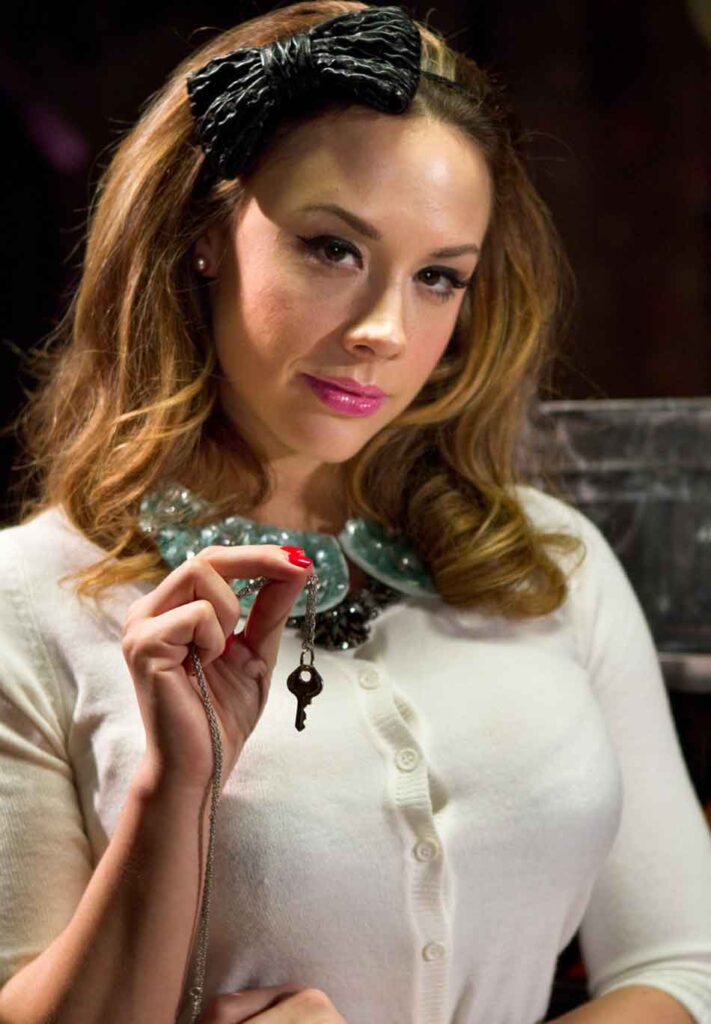Have you ever heard of chastity play?
It’s becoming more common in female-led relationships, and it can be a fun way to explore power dynamics and deepen intimacy.
Not everyone, or every couple likes to play, but it’s not as if its unheard of with female led relationships.
Basically, it involves using physical restraints like a chastity device to restrict a submissive partner’s access to sexual stimulation or release.
That’s the function, but you may be asking what good is it. What purpose can I use it for?
If you’re new to chastity play or just looking for some new ideas, you’re in luck.
In this article, we’re going to share 10 creative ways to use chastity play in a female-led relationship.

Table of Contents
What Is Chastity Play
So, what exactly is chastity play?
Well, it’s a way for a mistress to take control of her submissive partner’s sexual desires and behavior using physical restraints like a chastity device.
Essentially a check on his manhood.
This means that the submissive is restricted from accessing sexual stimulation or release, which can be a powerful way for the mistress to assert her dominance and reinforce the submissive’s submission.
But why would a mistress want to do this?
There are actually many reasons.
For one, it can be a way to establish clear boundaries and reinforce power dynamics in a female-led relationship.
By controlling the submissive’s access to sexual release, the mistress can assert her dominance and remind the submissive of his or her place.
On the other hand, chastity play can also be a way to enhance emotional connection and intimacy between partners.
By denying the submissive access to sexual release, the mistress can build sexual tension and anticipation, leading to a more intense and satisfying release when it does happen.
This can deepen the emotional connection between partners and create a more intimate and satisfying experience.
Chastity play can also be used as a form of behavior modification or punishment, with release from chastity used as a reward for good behavior.
This can help the submissive to learn and grow and can strengthen the power dynamics between partners.
Overall, chastity play can be a powerful tool for exploring power dynamics, enhancing intimacy, and modifying behavior in a consensual and respectful manner.
By giving the mistress control over the submissive’s sexual desires, both partners can deepen their connection and explore new erotic frontiers.

Is Chastity Play Necessary for a Female Led Relationship
It’s important to recognize that chastity play isn’t a required component of a female-led relationship (FLR).
You don’t HAVE to participate.
While it can be a valuable tool for establishing power dynamics and enhancing intimacy, it’s ultimately up to the individuals involved to decide if it’s something they want to try.
However, if it doesn’t align with both partners’ desires, there’s no pressure to incorporate it into their FLR.
There are many successful FLRs that don’t involve chastity play, so it’s completely acceptable to exclude it from your dynamic.
What matters most is that both partners feel safe, respected, and satisfied within their FLR.
But if it’s not something that appeals to you or your partner, don’t feel obligated to use it. Every FLR is unique to the individuals involved, and it’s up to them to decide what works best for them.

Choosing the Right Style of Chastity Play for Your FLR
So, as we talked about earlier, chastity play is a way to spice up your FLR and give your Mistress a tool for control.
But, let’s be clear, you don’t have to use it if it’s not your cup of tea.
However, if you’re curious about trying it out, there are different styles and levels of intensity you can choose from.
You could go for a simple plastic cage or a more elaborate metal one with intricate locking mechanisms. There’s also short-term play or long-term chastity to consider.
Before you dive into it, have a conversation with your Mistress or submissive about what works best for both of you.
What reasons can the mistress keep the submissive caged, and for what periods of time? Only for punishments, or can kinks be involved?
There are many questions around this issue.
Set boundaries and expectations, and make sure you both feel comfortable with what you’ve agreed on.
The most important thing is to build trust, communicate openly, and respect each other’s desires.
And don’t worry if it takes a little trial and error to find the right fit for your relationship.
It’s all about exploring and having fun while maintaining a healthy and safe FLR.
To sum it up, if you’re considering chastity play, take the time to choose the right style for your relationship.

10 Compelling Reasons to Try Chastity Play in Your FLR
If you’re thinking about incorporating chastity play into your female-led relationship (FLR), you might be curious about what benefits it can offer.
Petting a cage on his manhood is one thing, but why, what are you doing it for.
You need a reason, really. A purpose.
Whether you’re a dominant looking to enhance your control over your submissive or a submissive seeking to strengthen your connection with your partner, there are many reasons to explore this kink.
In this section, we’ll delve into ten compelling reasons why chastity play can be a valuable addition to your FLR.

Punishment
In a female-led relationship, the dominant partner or mistress may use chastity play as a form of punishment for any errant behavior deemed worthy of the use of chastity.
This can be a powerful tool for control, as the submissive partner will be aware that any disobedience or misbehavior can lead to a period of chastity.
It can also serve as a reminder of the submissive’s place in the relationship and the consequences of not following the mistress’s commands.
Additionally, the threat of chastity can be enough to deter the submissive from engaging in any behavior that the mistress deems unacceptable, thereby maintaining order and discipline in the FLR.
Overall, punishment through chastity play can be an effective way for the dominant partner to maintain control and discipline in the FLR.

Kinks
Exploring kinks can be an exciting way to deepen the connection between a mistress and her submissive in a female-led relationship.
One popular kink that incorporates chastity play is tease and denial, which involves arousing the submissive but not allowing them to orgasm, leading to a buildup of sexual tension.
Chastity can also be used for orgasm control, allowing the mistress to decide when and how the submissive is allowed to climax.
This level of control can be a powerful tool in a FLR, creating a dynamic of trust and intimacy between the partners.
Yet there’s a strong element of power play also.

Fidelity Assured
Another creative way to use chastity play in an FLR is to ensure fidelity.
The dominant partner, or mistress, can place the submissive partner in chastity whenever they are out of the house, out of sight, or even on nights out with friends.
Whenever the submissive male goes for a night out, he is first to put his cage on, the day before even, just to make extra sure he stays honest.
This mind game can be fun for both.
This can help eliminate the temptation to engage in any sexual activity with another person, and can add an interesting element of kink play to the relationship.

Extended Play
One creative use of chastity play is Extended Play.
This involves keeping the submissive in chastity for an extended period of time, which can help improve their focus and attentiveness.
The longer the male remains in chastity, the more he trends towards intimacy with his partner.
Many women report this phenomenon.
As the submissive becomes more desperate for release, they become more eager to please their mistress.
By testing the submissive with long periods of chastity, the mistress can ensure that the submissive’s attention is focused solely on her, ultimately strengthening their connection and relationship.
Although it’s recommended to build up this time, start with a few days, and build up the length he can stand.
Eventually, mistress gets an idea of when she can expect the submissive to be more affectionate.

Pleasure Focus
Another reason why a mistress may choose to use chastity play in her FLR is to shift the focus onto her pleasure.
By denying her submissive access to his own pleasure, she can encourage him to focus more on foreplay and her own enjoyment during sexual encounters.
Simply before any ‘after the sun goes down’ activity, the m
This can lead to a more fulfilling and satisfying sexual relationship for both parties, as well as deepening the power dynamic within the relationship.

Locktober
“Locktober” is a popular annual event in the world of chastity play, where participants commit to wearing a chastity device for the entire month of October.
It’s a great opportunity to connect with others who share your interest in this kink and can provide support and encouragement.
You can join online chat groups or forums, share tips and experiences, and make new friends in the community.
If you’re looking to explore chastity play further, participating in Locktober could be a fun and rewarding way to do so.

Humiliation and Power Play
In an FLR, humiliation and power play can be an exciting aspect of chastity play.
This type of play centers around the power dynamic between the mistress and the submissive, with the submissive being taunted about how he is under control.
The Mistress can use humiliation to remind the submissive of his place and reinforce the power dynamic. It can be a thrilling and exciting aspect of the FLR, but it’s important to ensure that both partners are comfortable with this level of play and that boundaries are respected.
Alternatively, she can ‘release him for a few moments’ and allow him 2 minutes to do what he feels like, before putting it back on.

The Release is a Reward
Another interesting way to use chastity play in a female-led relationship is to make the release of the submissive a reward.
The dominant can set a task or goal for the submissive, such as fixing something or learning a new skill, and then place him in chastity until it’s completed to her satisfaction.
Alternatively, the submissive can be locked up every Monday morning and only released when all his weekly chores are done.
This can be an effective way to ensure compliance and motivate the submissive to meet his obligations.

Self-Improvement Goals Hit
Another interesting idea for chastity play is using it to help your submissive partner achieve self-improvement goals.
For example, you could set a goal for them to lose a certain amount of weight each week, and weigh them each week to track their progress.
If they meet the goal, you can reward them by releasing them from chastity.
This can create a powerful incentive for your submissive to improve themselves and can make release a satisfying reward for their efforts.

Behavior Modification
Behavior modification is another way in which chastity play can be used in a female-led relationship.
If a submissive has bad habits or does something that annoys the dominant, the dominant can put them in chastity as punishment for a certain period of time.
Alternatively, the submissive can be released from chastity if they manage to change their behavior for a period of time.
The aim is to encourage the submissive to alter their behavior and avoid being placed in chastity.

Conclusion
In conclusion, exploring chastity play in a female-led relationship can offer a range of benefits, from punishment and power play to self-improvement and behavior modification.
By utilizing chastity play, the dominant partner can assert control and deepen intimacy with their submissive partner.
Whether it’s for extended play or the release as a reward, chastity play can be an exciting and interesting addition to an FLR.
It’s important to communicate openly with your partner and set boundaries to ensure a safe and enjoyable experience for both parties.
With patience, communication, and a sense of adventure, chastity play can enhance your FLR and bring you and your partner closer together.
Trying to talk to your partner about the benefits of a female led relationship can be hard. Use this open letter to help or to prompt constructive dialogue.


Leave a Reply